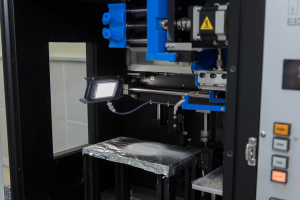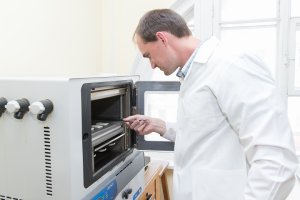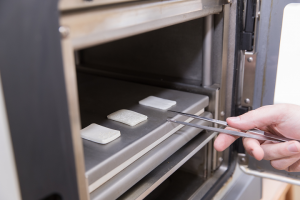Many researchers and scientists have turned to 3D printing for applications in tissue engineering, and a team from the Polymer Materials for Tissue Engineering and Transplantology Laboratory of Peter the Great St. Petersburg Polytechnic University (SPbPU) is no different. In a joint project with researchers from the Russian Academy of Sciences and Pavlov First St. Petersburg State Medical University, the SPbPU team has developed innovative, polymeric medical materials that can be used to fix human organs that have undergone trauma.
 The project is taking place under Project 5-100, a state support program for Russian universities that’s been going on since 2013. The goal of the project is to elevate the standing of Russian higher education institutes, so that they can move forward and strengthen their research and education initiatives by promoting R&D, streamlining administration, growing international cooperation, and providing incentives to attract top professors and facilitate existing faculty’s professional growth.
The project is taking place under Project 5-100, a state support program for Russian universities that’s been going on since 2013. The goal of the project is to elevate the standing of Russian higher education institutes, so that they can move forward and strengthen their research and education initiatives by promoting R&D, streamlining administration, growing international cooperation, and providing incentives to attract top professors and facilitate existing faculty’s professional growth.
For its part of Project 5-100, SPbPU invents, applies, and shares its cross-disciplinary polytechnic knowledge and advanced manufacturing technologies. In this instance, scientists at the university have created a porous, 3D material made of chitosan – a bone tissue analog – and collagen, which is the most promising material for fabricating tissue scaffolds. The new material can then be used to help restore lost parts of bone. The materials in this new medical area are referred to as mimicking materials, because they can actually trick the human body…but not in a bad way.
“We are not deceiving nature, we are just helping it to cope with a medical problem,” explained Vladimir Yudin, the Head of the Polymer Materials for Tissue Engineering and Transplantology Laboratory. “Experts are currently debating whether it is better to use an implant or restore an organ. A person with an artificial organ must take medication for the rest of their lifetime to prevent the body from rejecting it. This is not the case for tissue grown from human cells.”
Preclinical study results show that after a certain length of time, a 3D sponge embedded in human bone will begin to be covered in natural bone tissue as the artificial material decomposes. The researchers also studied the 3D collagen sponge in both muscle and liver tissue and found that the material can stimulate natural organ tissues to be restored.
The team published a paper on their research, titled “Bioresorption of Porous 3D Matrices Based on Collagen in Liver and Muscular Tissue,” in the Cell and Tissue Biology journal; co-authors include P. V. Popryadukhin, G. Y. Yukina, I. P. Dobrovolskaya, E. M. Ivankova, and Yudin.
The abstract reads, “Highly porous cylinder-shaped 3D matrices with diameters of 1.3 and 3 mm were obtained by lyophilization of collagen solution. A study in vivo of the mechanism and rate of resorption of the resulting material showed that complete resorption of the matrix occurred 6 weeks after their implantation into liver tissue and 3 weeks after implantation into muscle tissue of animals. Surrounding tissues were not altered or damaged. Histological analysis revealed that, simultaneously with the resorption of matrix collagen, connective tissue and blood vessels were formed. This allows us to recommend the developed porous material based on collagen for use as matrices for tissue engineering and cellular transplantation.”
 In the case of these mimicking materials, a polymer matrix is first implanted into damaged liver tissue, vessels, or bones, which have been saturated with the organ cells. The body is tricked into not rejecting the foreign object which has been implanted, as the materials are made from the biocompatible chitosan and collagen components. Eventually, this matrix will decompose, and the implanted artificial tissue will then be replaced by natural human tissue.
In the case of these mimicking materials, a polymer matrix is first implanted into damaged liver tissue, vessels, or bones, which have been saturated with the organ cells. The body is tricked into not rejecting the foreign object which has been implanted, as the materials are made from the biocompatible chitosan and collagen components. Eventually, this matrix will decompose, and the implanted artificial tissue will then be replaced by natural human tissue.
Implanted materials have to be able to stay whole, and not disintegrate before new, natural tissue is formed in its place. These biocompatible 3D polymer materials are special in that they not only stimulate the restoration of natural tissues, but they can also regulate the resorption time, so premature disintegration is not an issue.
The researchers also used their new 3D materials to develop suture threads, blood vessel prostheses and wound covers, which were all proven effective during in vivo preclinical trials. So according to SPbPU, these materials have been recommended for use in cellular transplantation and tissue engineering.
It’s a vitally important mission in the world of modern medicine to develop artificial organs for the purposes of transplant, and continued development in this field depends on scientists and researchers, like the multi-disciplinary team from SPbPU, the Russian Academy of Sciences, and Pavlov First St. Petersburg State Medical University, creating bioresorbable and biocompatible polymer materials.
Discuss this story and other 3D printing topics at 3DPrintBoard.com or share your thoughts in the Facebook comments below.
[Images: Peter the Great St. Petersburg Polytechnic University]Subscribe to Our Email Newsletter
Stay up-to-date on all the latest news from the 3D printing industry and receive information and offers from third party vendors.
Print Services
Upload your 3D Models and get them printed quickly and efficiently.
You May Also Like
3D Printing News Briefs, June 28, 2025: Defense Accelerator, Surgical Models, & More
In this weekend’s 3D Printing News Briefs, 3YOURMIND was selected to join an EU Defense Accelerator, and PTC has announced model-based definition (MBD) capabilities within Onshape. Finally, a study out...
3D Printing News Briefs, June 7, 2025: Digital Inventory, Thermal Management Solutions, & More
In this weekend’s 3D Printing News Briefs, UK-based 3D printing bureau 3D People responds to global instability, and AEWIN chose Fabric8Labs’ technology for advanced thermal management solutions. We’ll end with...
Low-Cost Binocular Indirect Ophthalmoscope Made with CAD Software & Bambu Lab X1C
3D printing is increasingly used in the fabrication of diagnostic equipment, including ophthalmology, which is a medical specialty that deals with the diagnosis and treatment of eye conditions and diseases....
3D Printing News Briefs, May 17, 2025: Color-Changing Materials, Humanoid Robot, & More
We’re covering research innovations in today’s 3D Printing News Briefs! First, Penn Engineering developed 3D printed materials that change color under stress, and UC Berkeley researchers created an open source,...





































